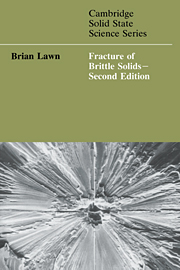Book contents
- Frontmatter
- Contents
- Preface
- Glossary of symbols and abbreviations
- 1 The Griffith concept
- 2 Continuum aspects of crack propagation I: linear elastic crack-tip field
- 3 Continuum aspects of crack propagation II: nonlinear crack-tip field
- 4 Unstable crack propagation: dynamic fracture
- 5 Chemical processes in crack propagation: kinetic fracture
- 6 Atomic aspects of fracture
- 7 Microstructure and toughness
- 8 Indentation fracture
- 9 Crack initiation: flaws
- 10 Strength and reliability
- References and reading list
- Index
10 - Strength and reliability
Published online by Cambridge University Press: 14 January 2010
- Frontmatter
- Contents
- Preface
- Glossary of symbols and abbreviations
- 1 The Griffith concept
- 2 Continuum aspects of crack propagation I: linear elastic crack-tip field
- 3 Continuum aspects of crack propagation II: nonlinear crack-tip field
- 4 Unstable crack propagation: dynamic fracture
- 5 Chemical processes in crack propagation: kinetic fracture
- 6 Atomic aspects of fracture
- 7 Microstructure and toughness
- 8 Indentation fracture
- 9 Crack initiation: flaws
- 10 Strength and reliability
- References and reading list
- Index
Summary
In turning to engineering aspects of brittle fracture the focus shifts from toughness to strength. However, structural design is concerned not just with strength but also with reliability. How may we guarantee the strength of a brittle component? Or, more realistically, how well may we guarantee the strength and for how long? Much of our current methodology for quantifying the reliability of intrinsically brittle materials can be traced back to the endeavours of Evans, Wiederhorn, Davidge, Ritter and others in the early 1970s to address such questions in relation to fracture mechanics, specifically in the context of failure from Griffith flaws.
Reliability inevitably embodies a probabilistic element. Designers reconcile themselves to the notion of a ‘risk’ of failure over a ‘lifetime’, acceptable values of these quantities depending on specific applications. The classical form in which risk is expressed for any mechanical structure (including, interestingly, the human body) is the ‘bathtub’ curve of fig. 10.1, representing the ‘hazard’ (mortality) rate as a function of time. Such a curve is certainly representative of the strength characteristics of ceramic components: component failure is most frequent during manufacture and initial screening or after prolonged wear and tear in stringent service environments.
It is in the recognition that variability in strength and lifetime is unavoidable that ‘flaw statistics’ enters as a central element of reliability analysis in brittle materials. One regards individual flaws as members of some determinable distribution.
- Type
- Chapter
- Information
- Fracture of Brittle Solids , pp. 335 - 362Publisher: Cambridge University PressPrint publication year: 1993



